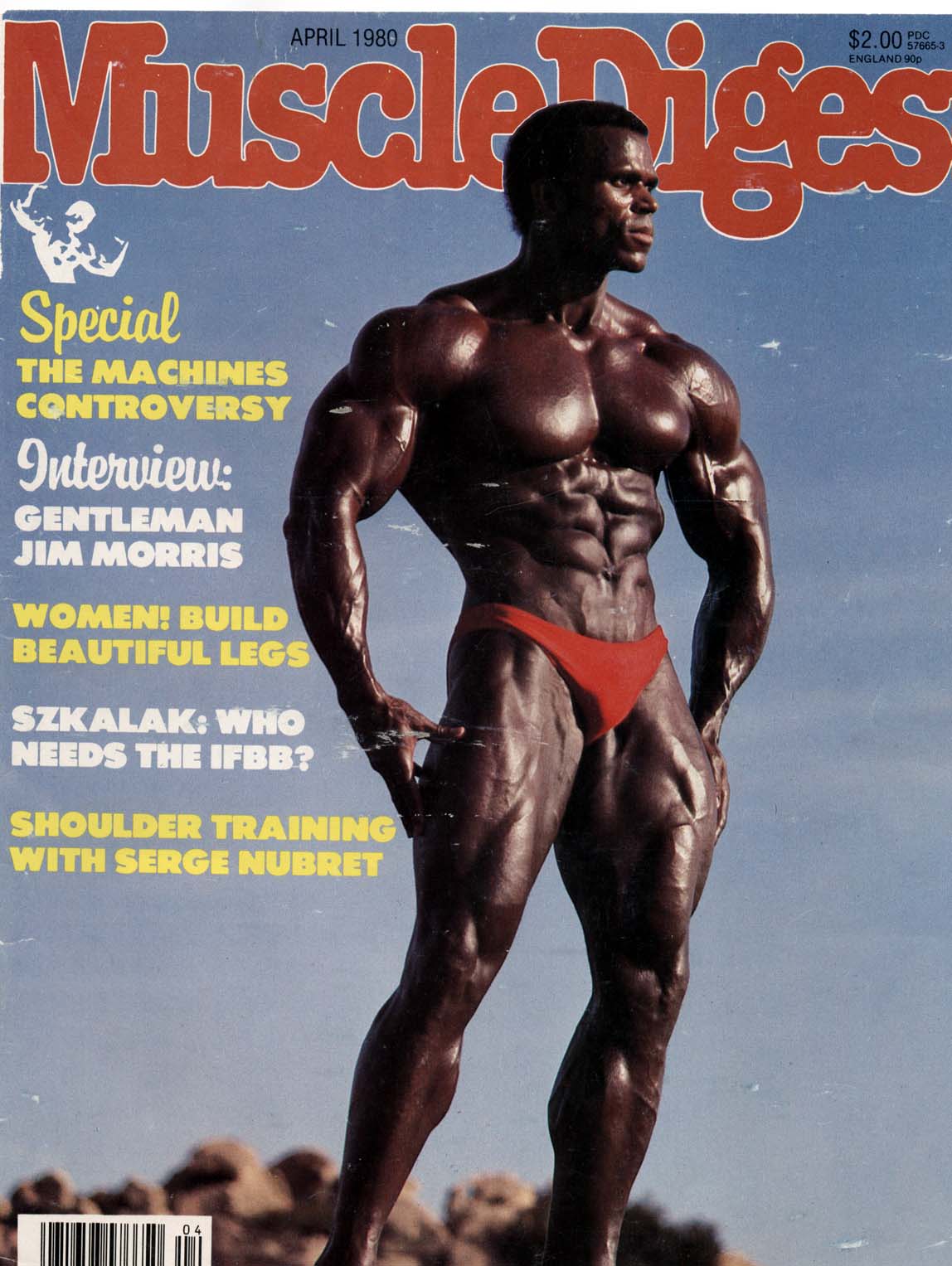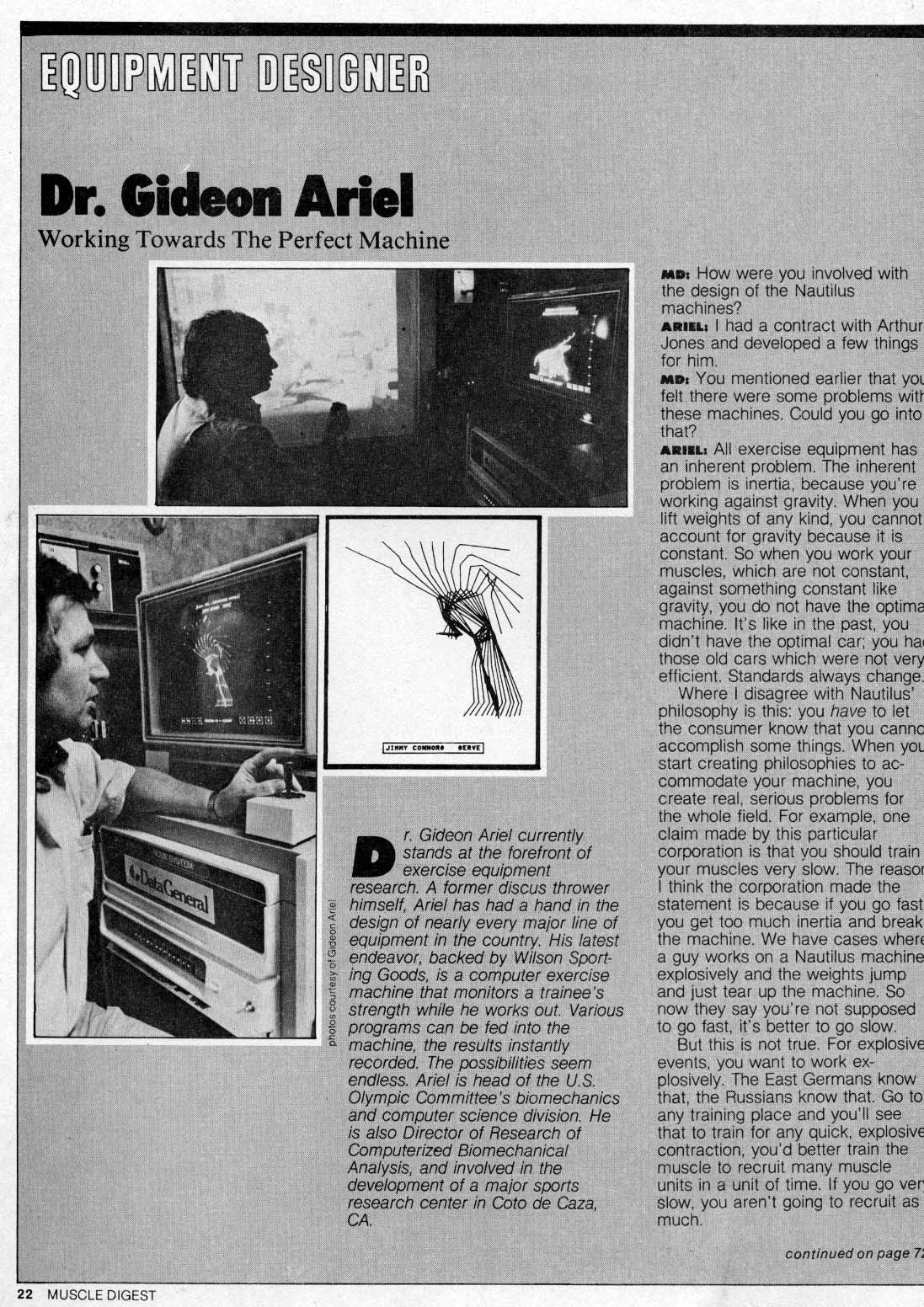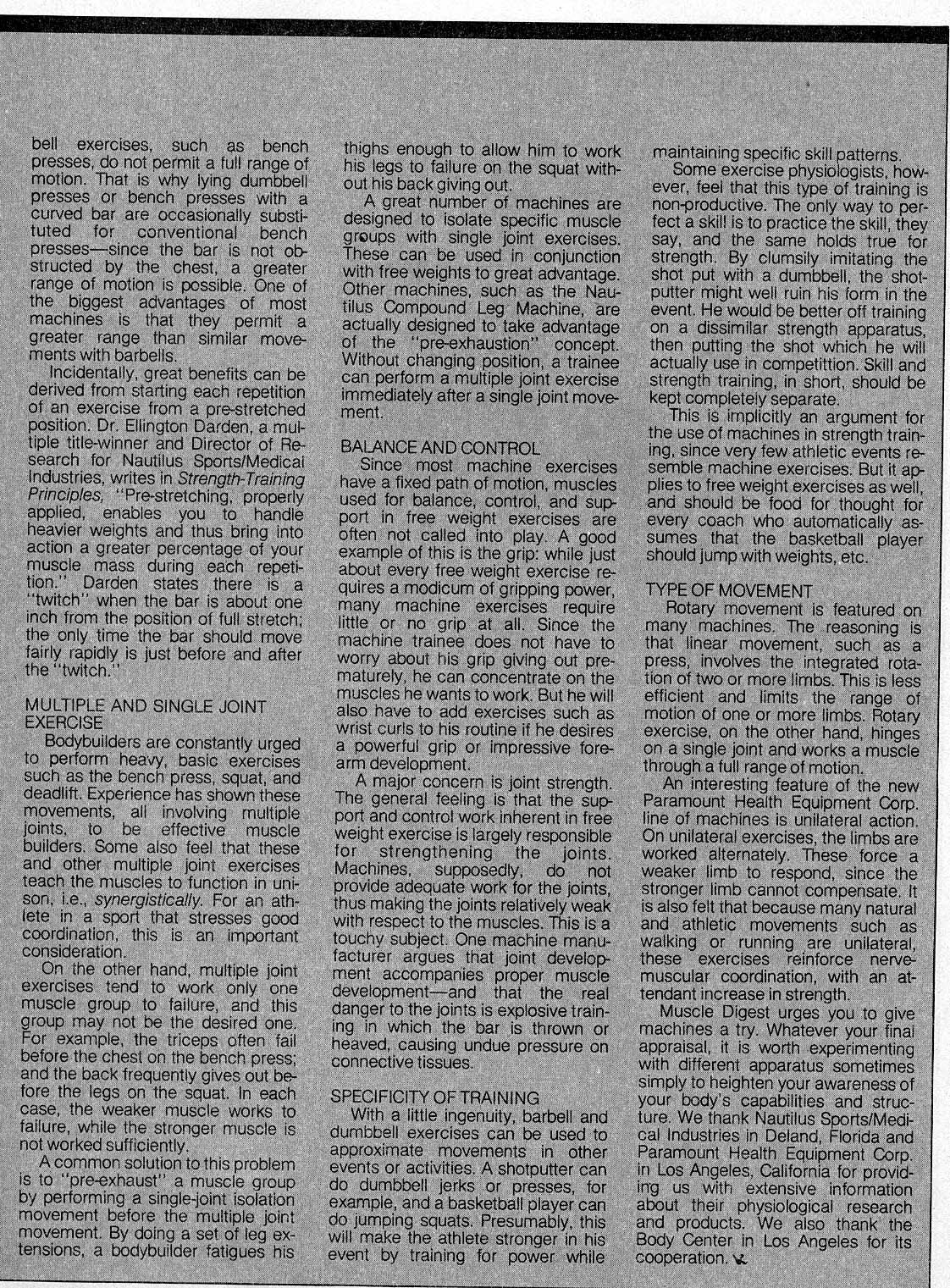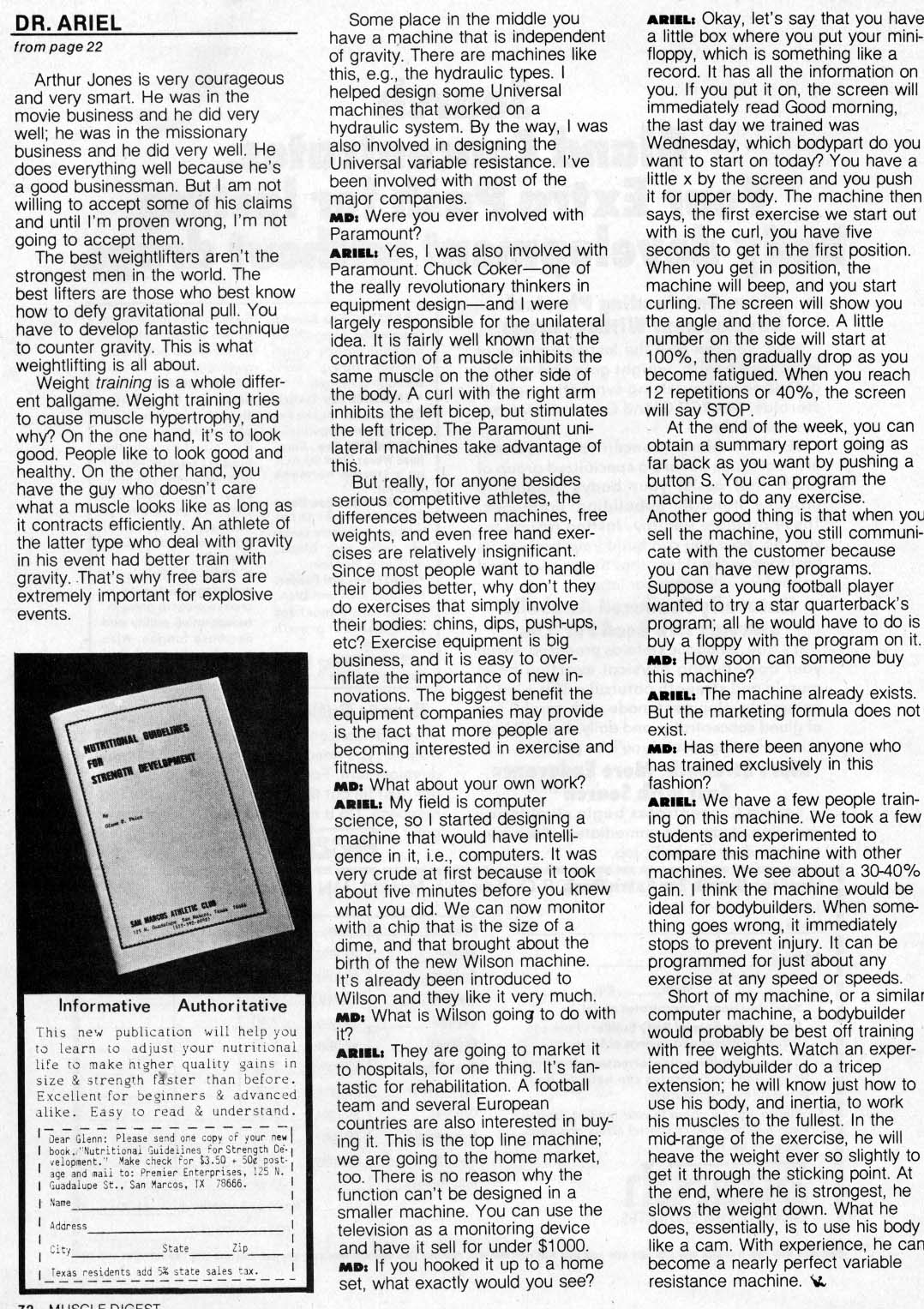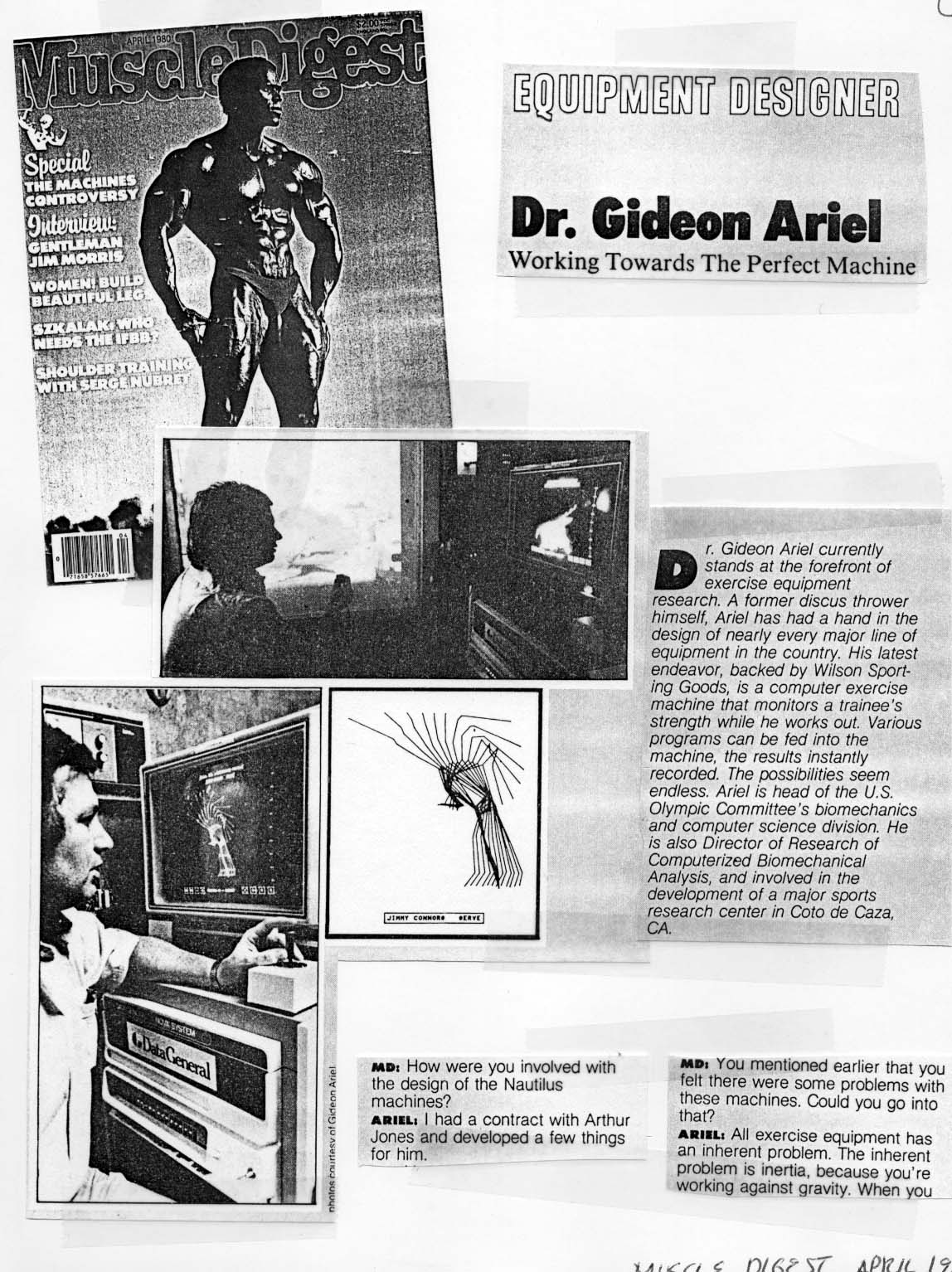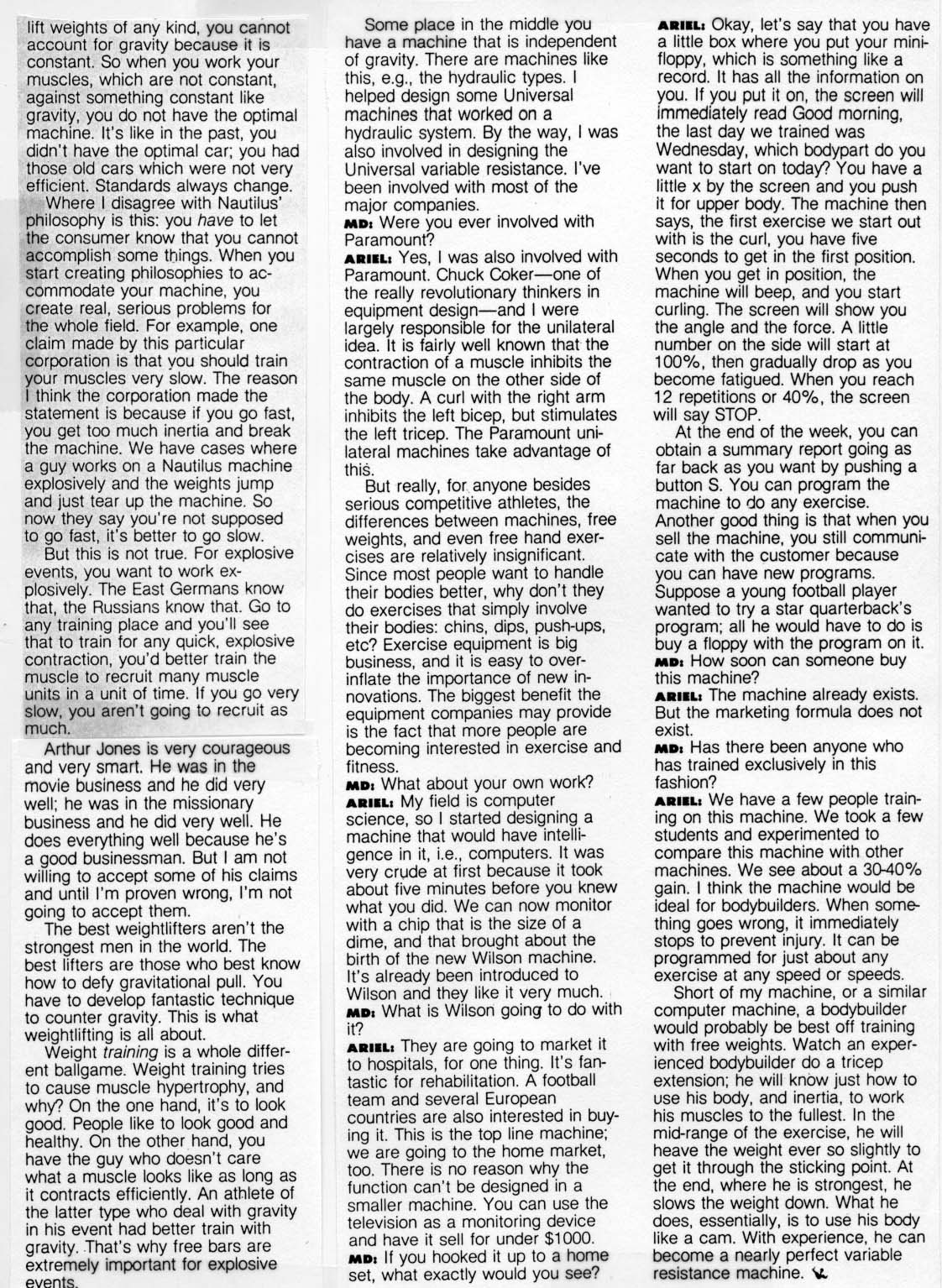Dr. Gideon Ariel Working Toward the perfect Machine
Equipment Designer
By Gideon Ariel in Muscle Digest on Tuesday, April 1, 1980
This article discusses the work of Dr. Gideon Ariel, a leading figure in exercise equipment research. Ariel, a former discus thrower, has contributed to the design of almost every major line of exercise equipment in the U.S. His latest project, supported by Wilson Sporting Goods, is a computerized exercise machine that tracks a user's strength during workouts. The machine can be programmed with various workout routines, and the results are recorded instantly. Ariel is also the head of the U.S. Olympic Committee's biomechanics and computer science division, the Director of Research of Computerized Biomechanical Analysis, and is involved in the development of a major sports research center in Coto de Caza, CA. The article also discusses the inherent problems with exercise equipment, the importance of training methods, and the future of exercise technology.
The article discusses the importance of body exercises and the role of exercise equipment in promoting fitness. It also introduces a new intelligent machine designed by a computer scientist, which is set to revolutionize the fitness industry. The machine, which is the size of a dime, can monitor and guide users through their workouts, providing real-time feedback on their performance. The machine is expected to be marketed to hospitals for rehabilitation purposes and to the general public. The machine's unique feature is its ability to be programmed for any exercise at any speed, providing a safer and more efficient workout. The article suggests that this machine could be particularly beneficial for bodybuilders.
Tip: use the left and right arrow keys
to
_T C-7:3
Y-2
1~ 5
Dr. Gideon Ariel
Working Towards The Perfect Machine
Dr. Gideon Ariel currently stands at the forefront of exercise equipment research. A former discus thrower himself, Ariel has had a hand in the design of nearly every major line of equipment in the country. His latest endeavor, backed by Wilson Sporting Goods, is a computer exercise machine that monitors a trainee's strength while he works out. Various programs can be fed into the machine, the results instantly recorded. The possibilities seem endless. Ariel is head of the U.S. Olympic Committee's biomechanics and computer science division. He is also Director of Research of Computerized Biomechanical Analysis, and involved in the development of a major sports research center in Coto de Caza, CA.
MD, How were you involved with the design of the Nautilus machines?
ARIELI I had a contract with Arthur Jones and developed a few things for him.
MD, You mentioned earlier that yoi felt there were some problems wit[ these machines. Could you go into that?
wRIEL= All exercise equipment has an inherent problem, The inherent problem is inertia, because you're working against gravity. When you lift weights of any kind. you cannot account for gravity because it is constant. So when you work your muscles, which are not constant, against something constant like gravity, you do not have the optima machine. It's like in the past, you didn't have the optimal car; you ha those old cars which were not very efficient. Standards always change.
Where I disagree with Nautilus' philosophy is this: you have to let the consumer know that you cannc accomplish some things. When yoL start creating philosophies to accommodate your machine, you create real, serious problems for the whole field. For example, one claim made by this particular corporation is that you should train your muscles very slow. The reasor I think the corporation made the statement is because if you go fast you get too much inertia and break the machine. We have cases when a guy works on a Nautilus machine explosively and the weights jump and just tear up the machine. So now they say you're not supposed to go fast, it's better to go slow.
But this is not true. For explosive events, you want to work explosively. The East Germans know that, the Russians know that. Go to any training place and you'll see that to train for any quick, explosive contraction, you'd better train the muscle to recruit many muscle units in a unit of time. If you go ver slow, you aren't going to recruit as much.
continued on page 7:
22 MUSCLE DIGEST
bell exercises, such as bench presses, do not permit a full range of motion. That is why lying dumbbell presses or bench presses with a curved bar are occasionally substituted for conventional bench presses-since the bar is not obstructed by the chest, a greater range of motion is possible. One of the biggest advantages of most machines is that they permit a greater range than similar movements with barbells.
Incidentally, great benefits can be derived from starting each repetition of an exercise from a pre-stretched position. Dr. Ellington Darden, a multiple title-winner and Director of Research for Nautilus Sports/Medical Industries, writes in Strength-Training Principles, "Pre-stretching, properly applied, enables you to handle heavier weights and thus bring into action a greater percentage of your muscle mass during each repetition." Darden states there is a "twitch" when the bar is about one inch from the position of full stretch; the only time the bar should move fairly rapidly is just before and after the "twitch."
MULTIPLE AND SINGLE JOINT EXERCISE
Bodybuilders are constantly urged to perform heavy, basic exercises such as the bench press, squat, and deadlift. Experience has shown these movements, all involving multiple joints, to be effective muscle builders. Some also feel that these and other multiple joint exercises teach the muscles to function in unison, i.e., synergistically. For an athlete in a sport that stresses good coordination, this is an important consideration.
On the other hand, multiple joint exercises tend to work only one muscle group to failure, and this group may not be the desired one. For example, the triceps often fail ;before the chest on the bench press; and the back frequently gives out before the legs on the squat. In each case, the weaker muscle works to failure, while the stronger muscle is not worked sufficiently.
A common solution to this problem is to "pre-exhaust" a muscle group by performing a single joint isolation movement before the multiple joint movement. By doing a set of leg extensions, a bodybuilder fatigues his
thighs enough to allow him to work his legs to failure on the squat without his back giving out.
A great number of machines are designed to isolate specific muscle groups with single joint exercises. These can be used in conjunction with free weights to great advantage. Other machines, such as the Nautilus Compound Leg Machine, are actually designed to take advantage of the "pre-exhaustion" concept. Without changing position, a trainee can perform a multiple joint exercise immediately after a single joint movement.
BALANCE AND CONTROL
Since most machine exercises have a fixed path of motion, muscles used for balance, control, and support in free weight exercises are often not called into play. A good example of this is the grip: while just about every free weight exercise requires a modicum of gripping power, many machine exercises require little or no grip at all. Since the machine trainee does not have to worry about his grip giving out prematurely, he can concentrate on the muscles he wants to work. But he will also have to add exercises such as wrist curls to his routine if he desires a powerful grip or impressive forearm development.
A major concern is joint strength. The general feeling is that the support and control work inherent in free weight exercise is largely responsible for strengthening the joints. Machines, supposedly, do not provide adequate work for the joints, thus making the joints relatively weak with respect to the muscles. This is a touchy subject. One machine manufacturer argues that joint development accompanies proper muscle development-and that the real danger to the joints is explosive training in which the bar is thrown or heaved, causing undue pressure on connective tissues.
SPECIFICITY OF TRAINING
With a little ingenuity, barbell and dumbbell exercises can be used to approximate movements in other events or activities. A shotputter can do dumbbell jerks or presses, for example, and a basketball player can do jumping squats. Presumably, this will make the athlete stronger in his event by training for power while
maintaining specific skill patterns.
Some exercise physiologists, however, feel that this type of training is non-productive. The only way to perfect a skill is to practice the skill, they say, and the same holds true for strength. By clumsily imitating the shot put with a dumbbell, the shotputter might well ruin his form in the event. He would be better off training on a dissimilar strength apparatus, then putting the shot which he will actually use in competittion. Skill and strength training, in short, should be kept completely separate.
This is implicitly an argument for the use of machines in strength training, since very few athletic events resemble machine exercises. But it applies to free weight exercises as well, and should be food for thought for every coach who automatically assumes that the basketball player should jump with weights, etc.
TYPE OF MOVEMENT
Rotary movement is featured on many machines. The reasoning is that linear movement, such as a press, involves the integrated rotation of two or more limbs. This is less efficient and limits the range of motion of one or more limbs. Rotary exercise, on the other hand, hinges on a single joint and works a muscle through a full range of motion.
An interesting feature of the new Paramount Health Equipment Corp. line of machines is unilateral action. On unilateral exercises, the limbs are worked alternately. These force a weaker limb to respond, since the stronger limb cannot compensate. It is also felt that because many natural and athletic movements such as walking or running are unilateral, these exercises reinforce nervemuscular coordination, with an attendant increase in strength.
Muscle Digest urges you to give machines a try. Whatever your final. appraisal, it is worth experimenting with different apparatus sometimes simply to heighten your awareness of your body's capabilities and structure. We thank Nautilus Sports/Medical Industries in Deland, Florida and Paramount Health Equipment Corp. in Los Angeles. California for providing us with extensive information about their physiological research and products. We also thank the Body Center in Los Angeles for its cooperation.'
DR. ARIEL
from page 22
Arthur Jones is very courageous and very smart. He was in the movie business and he did very well; he was in the missionary business and he did very well. He does everything well because he's a good businessman. But I am not willing to accept some of his claims and until I'm proven wrong, I'm not going to accept them.
The best weightlifters aren't the strongest men in the world. The best lifters are those who best know how to defy gravitational pull. You have to develop fantastic technique to counter gravity. This is what weightlifting is all about.
Weight training is a whole different ballgame. Weight training tries to cause muscle hypertrophy, and why? On the one hand, it's to look good. People like to look good and healthy. On the other hand, you have the guy who doesn't care what a muscle looks like as long as it contracts efficiently. An athlete of the latter type who deal with gravity in his event had better train with gravity. That's why free bars are extremely important for explosive events.
Informative Authoritative
I his no-d puhlr,_aii.:n ,d: help .,'u
Darn ,o adjust ;our cutrrtwna: Me to make nigher quality gains ir size & strength frdster 'han before. Excellent for beginners & advancee alike. Easy to read & understand.
I Jear Glenn: please send are copy :r sour new I book.�kucritionai luideiines 'or Strength Ce�1
elopmert." Make check icr t3.50501! S0a Cost- age arc mail to: premier Enterprises, ..5 B. I I Suaciaiuoe St.. San warcos. IX 'S6,6. I
I I
State I
1 'exas residents aaa 'A state saxes 'ix. I -----------------
Some place in the middle you have a machine that is independent of gravity. There are machines like this, e.g., the hydraulic types. I helped design some Universal machines that worked on a hydraulic system. By the way, I was also involved in designing the Universal variable resistance. I've been involved with most of the major companies. MPi Were you ever involved with Paramount?
ARUU Yes, I was also involved with Paramount. Chuck Coker-one of the really revolutionary thinkers in equipment design-and I were largely responsible for the unilateral idea. It is fairly well known that the contraction of a muscle inhibits the same muscle on the other side of the body. A curl with the right arm inhibits the left bicep, but stimulates the left tricep. The Paramount unilateral machines take advantage of this.
But really, for anyone besides serious competitive athletes, the differences between machines, free weights, and even free hand exercises are relatively insignificant. Since most people want to handle their bodies better, why don't they do exercises that simply involve their bodies: chins, dips, push-ups, etc? Exercise equipment is big business, and it is easy to overinflate the importance of new innovations. The biggest benefit the equipment companies may provide is the fact that more people are becoming interested in exercise and fitness.
mm What about your own work? A IIU My field is computer science, so I started designing a machine that would have intelligence in it, i.e., computers. It was very crude at first because it took about five minutes before you knew what you did. We can now monitor with a chip that is the size of a dime, and that brought about the birth of the new Wilson machine. It's already been introduced to Wilson and they like it very much. mm What is Wilson going to do with it?
AmmIU They are going to market it to hospitals, for one thing. It's fantastic for rehabilitation. A football team and several European countries are also interested in buying it. This is the top line machine; we are going to the home market, too. There is no reason why the function can't be designed in a smaller machine. You can use the television as a monitoring device and have it sell for under $1000. MD, If you hooked it up to a home set, what exactly would you see?
A UU Okay, let's say that you havE a little box where you put your mini floppy, which is something like a record. It has all the information on you. If you put it on, the screen will immediately read Good morning, the last day we trained was Wednesday, which bodypart do you want to start on today? You have a little x by the screen and you push it for upper body. The machine then says, the first exercise we start out with is the curl, you have five seconds to get in the first position. When you get in position, the machine will beep, and you start curling. The screen will show you the angle and the force. A little number on the side will start at 100%, then gradually drop as you become fatigued. When you reach 12 repetitions or 40%, the screen will say STOP.
At the end of the week, you can obtain a summary report going as far back as you want by pushing a button S. You can program the machine to do any exercise. Another good thing is that when yoL sell the machine, you still communicate with the customer because you can have new programs. Suppose a young football player wanted to try a star quarterback's program; all he would have to do is buy a floppy with the program on it. Mre= How soon can someone buy this machine?
wRUU The machine already exists. But the marketing formula does not exist.
mm Has there been anyone who has trained exclusively in this fashion?
wRUU We have a few people training on this machine. We took a few students and experimented to compare this machine with other machines. We see about a 30-40% gain. I think the machine would be ideal for bodybuilders. When something goes wrong, it immediately stops to prevent injury. It can be programmed for just about any exercise at any speed or speeds.
Short of my machine, or a similar computer machine, a bodybuilder would probably be best off training with free weights. Watch an experienced bodybuilder do a tricep extension: he will know just how to use his body, and inertia, to work his muscles to the fullest. In the mid-range of the exercise, he will heave the weight ever so slightly to get it through the sticking point. At the end, where he is strongest, he slows the weight down. What he does, essentially, is to use his body like a cam. With experience, he can become a nearly perfect variable resistance machine, v.
I 'ame
I ~daress
I
I
I
+.. u, non, r n,t'roT
Working Towards The Perfect Machine
MD How were you involved with the design of the Nautilus machines?
ADUILs I had a contract with Arthur Jones and developed a few things for him.
Dr. Gideon Ariel currently stands at the forefront of exercise equipment research. A former discus thrower himself, Ariel has had a hand in the design of nearly every major line of equipment in the country. His latest endeavor, backed by Wilson Sporting Goods, is a computer exercise machine that monitors a trainee's strength while he works out. Various programs can be fed into the machine, the results instantly recorded. The possibilities seem endless. Ariel is head of the U.S. Olympic Committee's biomechanics and computer science division. He is also Director of Research of Computerized Biomechanical Analysis, and involved in the development of a major sports research center in Coto de Caza, CA.
MDI You mentioned earlier that you felt there were some problems with these machines. Could you go into that?
AlliLs All exercise equipment has an inherent problem. The inherent problem is inertia, because you're working against gravity. When you
Y A, t�~~ -C ill (;r` Si API?/r_ l 5
lift weights of any kind, you cannot
account for gravity because it is constant. So when you work your
muscles, which are not constant, against something constant like gravity, you do not have the optimal machine. It's like in the past, you didn't have the optimal car; you had those old cars which were not very efficient. Standards always change.
Where I disagree with Nautilus' philosophy is this: you have to let the consumer know that you cannot accomplish some things. When you start creating philosophies to accommodate your machine, you create real, serious problems for the whole field. For example, one claim made by this particular corporation is that you should train your muscles very slow. The reason I think the corporation made the statement is because if you go fast, you get too much inertia and break the machine. We have cases where a guy works on a Nautilus machine explosively and the weights jump and just tear up the machine. So now they say you're not supposed to go fast, it's better to go slow.
But this is not true. For explosive events, you want to work explosively. The East Germans know that, the Russians know that. Go to any training place and you'll see that to train for any quick, explosive contraction, you'd better train the muscle to recruit many muscle units in a unit of time. If you go very slow, you aren't going to recruit as much.
Arthur Jones is very courageous and very smart. He was in the movie business and he did very well; he was in the missionary business and he did very well. He does everything well because he's a good businessman. But I am not willing to accept some of his claims and until I'm proven wrong, I'm not going to accept them.
The best weightlifters aren't the strongest men in the world. The best lifters are those who best know how to defy gravitational pull. You have to develop fantastic technique to counter gravity. This is what weightlifting is all about.
Weight training is a whole different ballgame. Weight training tries to cause muscle hypertrophy, and why? On the one hand, it's to look good. People like to look good and healthy. On the other hand, you have the guy who doesn't care what a muscle looks like as long as it contracts efficiently. An athlete of the latter type who deal with gravity in his event had better train with gravity. That's why free bars are extremely important for explosive events.
Some place in the middle you have a machine that is independent of gravity. There are machines like this, e.g., the hydraulic types. I helped design some Universal machines that worked on a hydraulic system. By the way, I was also involved in designing the Universal variable resistance. I've
been involved with most of the major companies.
MD Were you ever involved with Paramount?
a uii. Yes, I was also involved with Paramount. Chuck Coker-one of the really revolutionary thinkers in equipment design-and I were largely responsible for the unilateral idea. It is fairly well known that the contraction of a muscle inhibits the same muscle on the other side of the body. A curl with the right arm inhibits the left bicep, but stimulates the left tricep. The Paramount uni
lateral machines take advantage of this.
But really, for anyone besides serious competitive athletes, the differences between machines, free weights, and even free hand exercises are relatively insignificant. Since most people want to handle their bodies better, why don't they do exercises that simply involve their bodies: chins, dips, push-ups, etc? Exercise equipment is big business, and it is easy to overinflate the importance of new innovations. The biggest benefit the equipment companies may provide is the fact that more people are becoming interested in exercise and fitness.
MD What about your own work? wRUL: My field is computer science, so I started designing a machine that would have intelligence in it, i.e., computers. It was very crude at first because it took about five minutes before you knew what you did. We can now monitor with a chip that is the size of a dime, and that brought about the birth of the new Wilson machine. It's already been introduced to Wilson and they like it very much. MDI What is Wilson going to do with it?
wR,ii They are going to market it to hospitals, for one thing. It's fantastic for rehabilitation. A football team and several European countries are also interested in buying it. This is the top line machine; we are going to the home market, too. There is no reason why the function can't be designed in a smaller machine. You can use the television as a monitoring device and have it sell for under $1000. MPt If you hooked it up to a home set, what exactly would you see?
ADIILs Okay, let's say that you have
a little box where you put your mini
floppy, which is something like a
record. It has all the information on
you. If you put it on, the screen will
immediately read Good morning, the last day we trained was Wednesday, which bodypart do you want to start on today? You have a little x by the screen and you push it for upper body. The machine then says, the first exercise we start out with is the curl, you have five seconds to get in the first position. When you get in position, the machine will beep, and you start curling. The screen will show you the angle and the force. A little number on the side will start at 100%, then gradually drop as you become fatigued. When you reach 12 repetitions or 40%, the screen will say STOP.
At the end of the week, you can obtain a summary report going as far back as you want by pushing a button S. You can program the machine to do any exercise. Another good thing is that when you sell the machine, you still communicate with the customer because you can have new programs. Suppose a young football player wanted to try a star quarterback's program; all he would have to do is buy a floppy with the program on it. MD How soon can someone buy this machine?
*midi The machine already exists. But the marketing formula does not exist.
MDI Has there been anyone who has trained exclusively in this fashion?
ARUL We have a few people training on this machine. We took a few students and experimented to compare this machine with other machines. We see about a 30-40% gain. I think the machine would be ideal for bodybuilders. When something goes wrong, it immediately stops to prevent injury. It can be programmed for just about any exercise at any speed or speeds.
Short of my machine, or a similar computer machine, a bodybuilder would probably be best off training with free weights. Watch an experienced bodybuilder do a tricep extension; he will know just how to use his body, and inertia, to work his muscles to the fullest. In the mid-range of the exercise, he will heave the weight ever so slightly to get it through the sticking point. At the end, where he is strongest, he slows the weight down. What he does, essentially, is to use his body like a cam. With experience, he can become a nearly perfect variable resistance machine. v.

